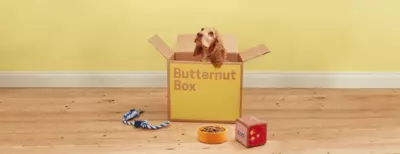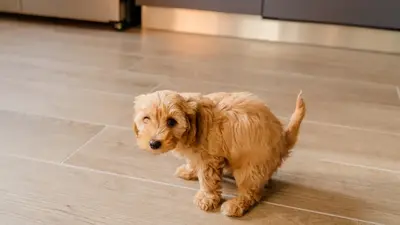How to Prepare for Getting a Puppy
- 28 Oct 2020
- 3m read

By Team Butternut Box
Your new puppy is almost ready to come and join you, and excitement is (understandably) reaching fever pitch. Make the most of this time by getting organised for the new arrival. The better prepared you are, the quicker your pup will settle in. You can start by shopping for your new furry family member, which is the best fun from start to finish. They'll need a comfy bed, food and water bowls, toys and grooming equipment. Somewhat less exciting but completely essential, get plenty of puppy pads and poo bags too. Pick up a crate for travelling, and possibly for sleeping and using as a safe space. Your pup will need to start out with the food their breeder or centre has been feeding them. But if you're planning to switch to a high-quality diet like Butternut Box, we can help you with the transition.
Preparing for a puppy
You can also pass the time by building a great big countdown clock and watching the hours tick down. Actually, sorry, what we meant to say was you can also pass the time preparing your home. Which room will be the puppy's designated space while they're settling in? The kitchen is a common choice: it's where most dogs are fed, it's generally warm and often has easy access outdoors for toilet training. Kitchens also tend to be quite busy, so your new pet will get used to their family's comings and goings and never feel isolated. To puppy-proof your house, try to think like a pup. Are there wires to chew, cupboards to nudge open, ledges to fall off, tempting bins to take a nose-dive into? Those baby stair gates are brilliant for closing off rooms (and indeed, stairs) and keeping your puppy safely corralled until they've settled in. Find a cosy place for their bed and crate – if you're using one – that's free from draughts.
Bringing your puppy home
The crate's in the car, and you've lovingly stuffed it full of soft and comforting blankets. If it's a long trip, you've packed food and water. Now it's time to go and get your new friend. The puppy will understandably feel unsettled on the way, so expect a few whines and whimpers. Keep the temperature moderate and the noise levels down. Stop regularly to check on them (and possibly change the bedding). When you get home, take the crate straight to the puppy's new room and close the door. Keep things as reassuringly calm as possible and try to avoid too much human squealing. We know – this is difficult when faced with those giant paws and a tail set on hyper-wag. Open the door of the crate and let them venture out in their own time. Some confident chaps come bounding straight out, while others prefer to take a little longer. Welcome home, pup.
Starting to socialise
Your puppy will soon be back in the car on their way to see the vet. Most puppies will have had their first vaccinations (the 8- to 10-week ones) before they left the breeders. They need a second dose a few weeks later, as well as their microchip. Until the vaccinations are complete, keep your pup away from public spaces where they might encounter unvaccinated dogs. Jabs done, it's really important to get your pup used to other dogs and humans, to help them grow up confident and sociable. A young dog is naturally enthusiastic and inquisitive, so it's a great time to introduce them to new people and pets. Just be aware that the world can suddenly get too much, and they may become overwhelmed. Little and often is the best way for a pup to hang out with new buddies. A puppy class hosted by an experienced dog trainer is an ideal way for your four-legged family member to have fun, make friends and learn what goes on in the wider world.

.jpeg)
.webp)

